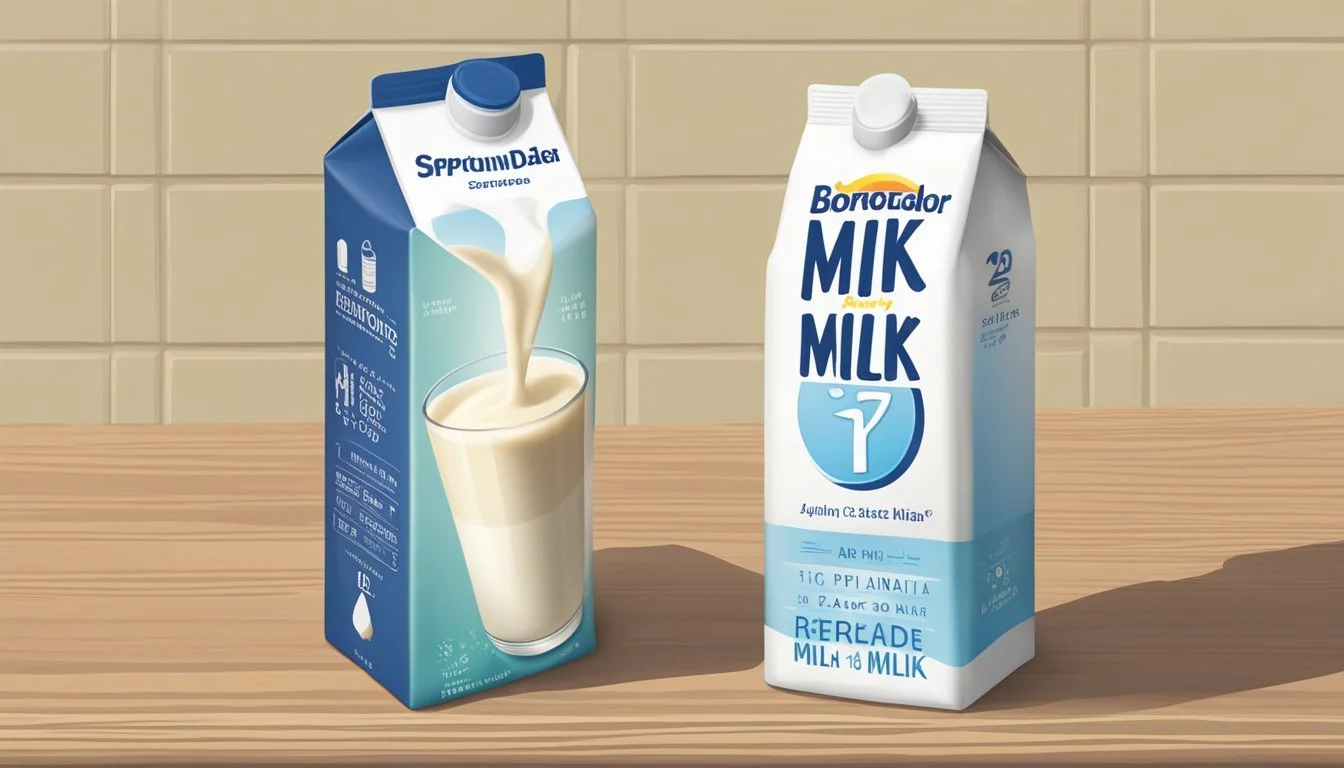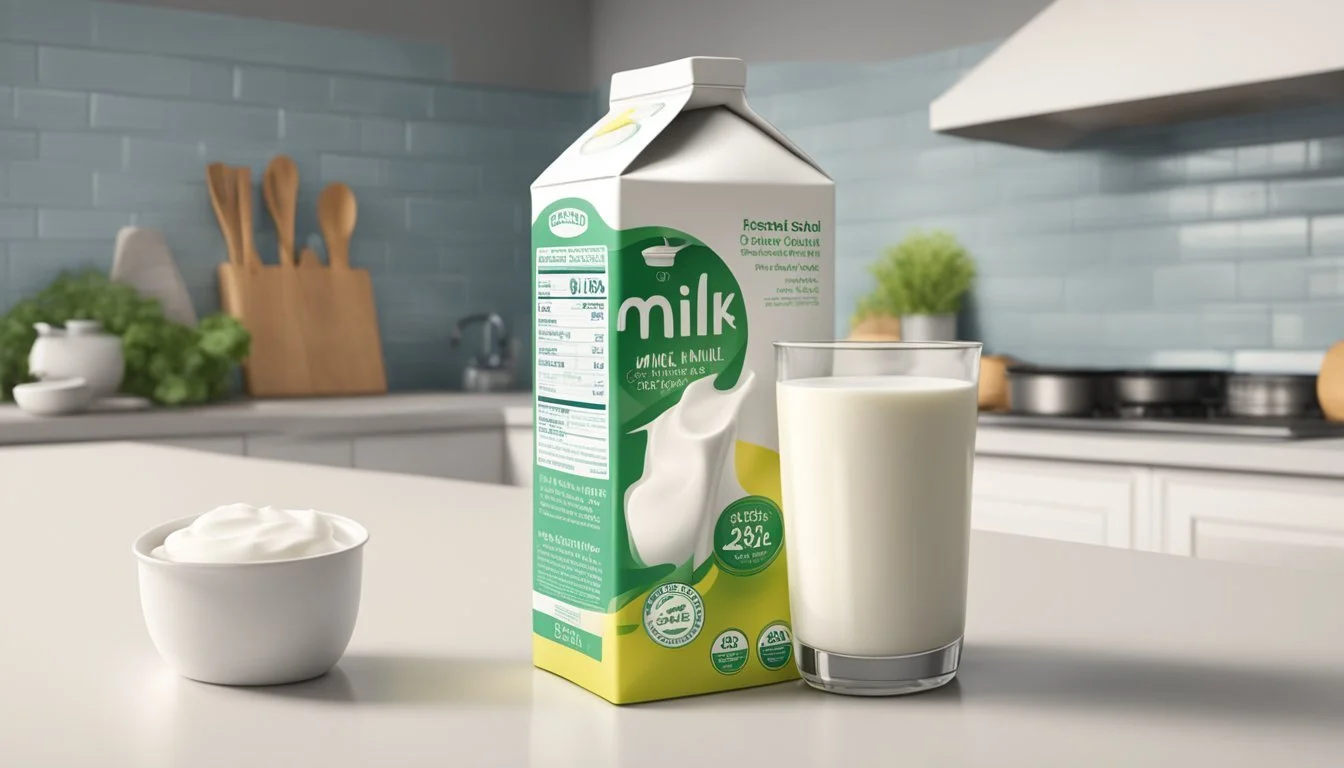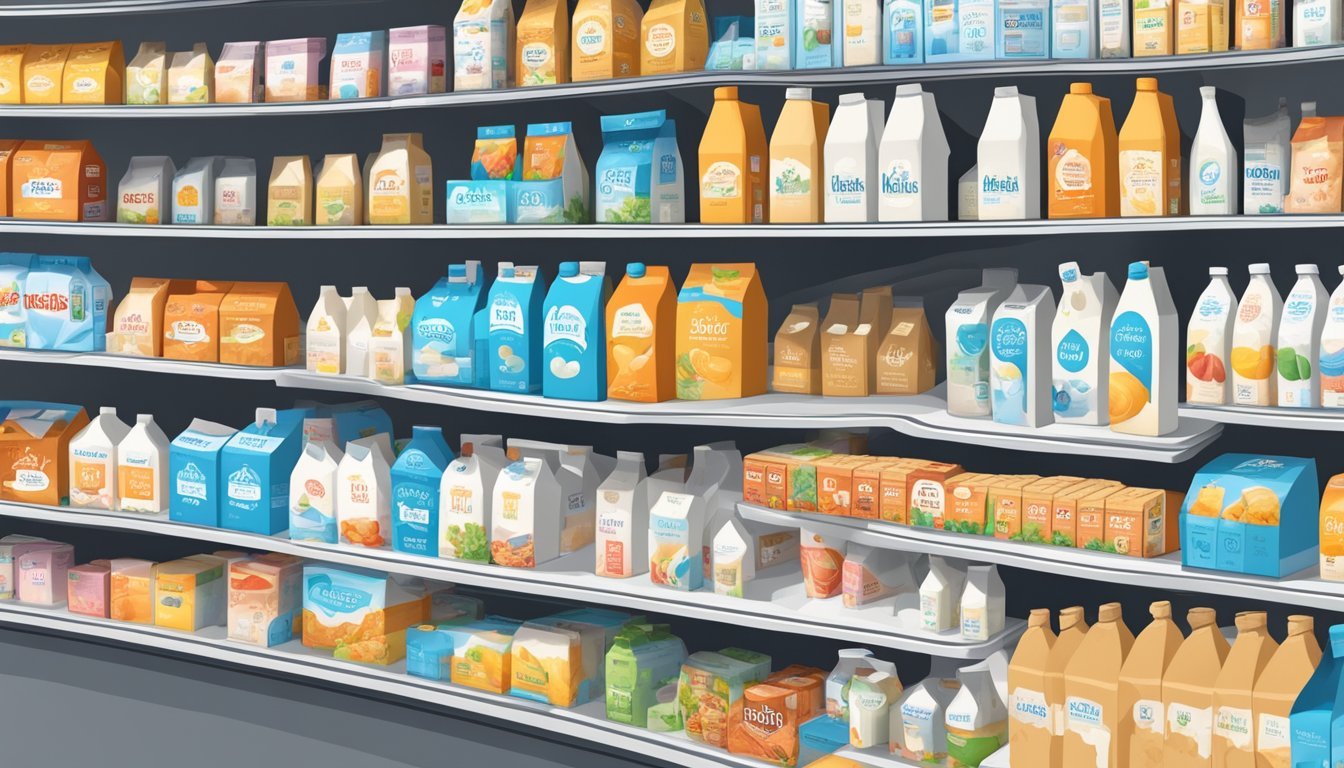How Long Does Boxed Milk Last?
Unveiling Shelf-Stable Milk's Lifespan
Boxed milk, commonly referred to as shelf-stable milk, has a significantly longer shelf life compared to its refrigerated counterparts due to the ultra-high temperature pasteurization process it undergoes. This process involves heating the milk to temperatures between 280 to 300 degrees Fahrenheit, which effectively eliminates bacteria and extends the product's shelf life without the need for refrigeration. As a result, shelf-stable milk can be stored at room temperature until it's opened.
One may find that the shelf life of shelf-stable milk varies between brands. Some manufacturers, such as Maple Hill Creamery, assert that their shelf-stable milk will last for upwards of 50 days at a room temperature of 75°F. Another brand, Organic Valley, reports that their product can last from six to nine months unopened. However, once the seal is broken, it is recommended to store the milk in the refrigerator where it will remain fresh for 5 to 7 days.
It is essential to note that despite the longer shelf life, once a consumer opens shelf-stable milk, they should treat it just like regular milk. They should refrigerate and consume it within the recommended timeframe post-opening to ensure the best quality and taste. This type of milk is available in an array of options including dairy, soy, almond, and coconut, catering to various dietary preferences and needs.
Understanding Shelf-Stable Milk
Shelf-stable milk is a convenient option that remains safe to consume without refrigeration for extended periods, thanks to its specialized processing and packaging.
Definition and Types of Shelf-Stable Milk
Shelf-stable milk includes a variety of milk products that can be stored at room temperature until their respective expiration dates. Typical types of shelf-stable milks include soy, almond, coconut, and cashew milk along with dairy-based options. These products are kept sterile and safe from spoilage through processes like ultra-high temperature (UHT) pasteurization, where milk is heated to very high temperatures, typically between 280 to 300 degrees Fahrenheit, to destroy harmful microorganisms.
Shelf Life and Storage Conditions
The shelf life of unopened shelf-stable milk can range significantly. Some brands claim their product can last up to nine months when stored properly. The key storage condition is maintaining a consistent room temperature, ideally around 75°F. Once opened, these milks should be refrigerated and are usually best when consumed within 5 to 7 days.
Aseptic Packaging and Sterilization Processes
Shelf-stable milk is typically housed in aseptic packaging, which is designed to keep the contents sterile. The process involves both aseptic processing and aseptic packaging: milk is sterilized by being heated at high temperatures and then is immediately transferred to sterilized containers in a sterile environment. This method ensures that milk can be preserved safely for long periods without the need for refrigeration until opened.
Health and Nutrition
Shelf-stable milk, often found in aseptic packaging, retains essential nutrients through the shelf life while ensuring safety through Ultra-High Temperature (UHT) pasteurization.
Nutritional Comparison with Refrigerated Milk
Shelf-stable (boxed) milk offers similar nutritional values to its refrigerated counterparts. It is an excellent source of proteins, with an average of 8 grams per cup, and rich in calcium, which is crucial for bone health. Shelf-stable milk typically contains comparable amounts of vitamins A and D, which are vital for immune function and bone health, respectively.
Vitamins and Minerals Content
The vitamin and mineral content of shelf-stable milk does not significantly differ from that of refrigerated milk. One serving generally provides about 30% of the recommended daily calcium intake and is fortified with vitamins A and D. Shelf-stable milk often includes these key nutrients:
Calcium: Essential for bones and teeth
Vitamin D: Facilitates calcium absorption
Vitamin A: Supports vision and the immune system
Proteins: Crucial for muscle repair and growth
Benefits of UHT Pasteurization
UHT pasteurization involves heating milk to about 280-300 degrees Fahrenheit for two to six seconds, effectively eliminating harmful bacteria. This process extends the shelf life of milk without necessitating refrigeration before opening and ensures the safety of consumption. Moreover, the high-temperature treatment is carefully calibrated to sustain the milk's nutrition profile, including valuable proteins and vitamins, making it a nutritious choice equivalent to conventionally pasteurized milk.
Safety and Quality Considerations
When considering the safety and quality of boxed milk, it's important to understand that the integrity of the product relies on controlled pasteurization processes and packaging standards. These factors contribute significantly to the prevention of bacterial growth, the maintenance of flavor, and adherence to regulations.
Bacteria and Spoilage Prevention
Pasteurization is a critical safety step in the production of boxed milk. By using ultra-high temperature (UHT) methods, milk is heated to between 280-300 degrees Fahrenheit for a short period, typically two to six seconds. This process eliminates harmful bacteria that can cause spoilage and disease, effectively extending the shelf life of the product to up to nine months when unopened and stored properly.
Taste, Texture, and Flavor Preservation
To preserve the taste and texture of boxed milk, packaging is done in sterile, aseptic conditions. This preserves the flavor and prevents contamination. Temperature control is also vital; while boxed milk can be stored at room temperature before opening, manufacturers often recommend refrigeration before consumption to ensure optimal flavor.
FDA Standards and Regulations
The Food and Drug Administration (FDA) sets forth regulations regarding the safety and labeling of shelf-stable milk. These standards ensure that products meet minimum safety requirements to prevent foodborne illnesses. The FDA also mandates clear labeling, including the use of expiration dates, to inform consumers of the shelf life and ensure the safe consumption of these dairy products.
Storage and Usage Tips
Maximizing the shelf life and maintaining the quality of boxed milk relies on proper storage and handling. These guidelines help ensure that one enjoys the full benefits of shelf-stable milk from the moment of purchase to the last drop.
Proper Pantry Storage Practices
When storing boxed milk in the pantry, it is crucial to keep it in a cool and dry place. Pantry shelves should maintain a consistent room temperature, ideally below 75°F (24°C), to preserve the quality of the milk. High temperatures and direct sunlight can compromise the shelf life and flavor.
Consistency: Maintain a constant temperature, avoiding fluctuating conditions.
Location: Situate your boxed milk away from any sources of heat or light.
Refrigerating After Opening
Once a carton of shelf-stable milk is opened, it requires refrigeration. Place the open carton in the refrigerator and consume it within 5 to 7 days for best quality. Keep the temperature of the refrigerator below 40°F (4°C) to ensure safety and maintain freshness.
Sealing: To prevent milk from absorbing flavors, seal it tightly if possible.
Positioning: Store away from the refrigerator door to avoid exposure to varying temperatures.
Cooking and Baking Uses
Boxed milk is versatile for both cooking and baking, serving as a suitable substitute for fresh milk. It's recommended to chill the milk if one prefers a cold element while serving, though it can be used at room temperature if it's going to be heated or baked.
Mixing: Incorporate it into recipes as one would with traditional milk.
Serving: If using the milk for drinking or in cold dishes, refrigerate beforehand for a pleasant, cool taste.
Advantages over Refrigerated Milk
Shelf-stable milk, with its extended shelf life and durable packaging, offers notable advantages over its refrigerated counterparts—specifically in terms of convenience, waste reduction, and environmental impact.
Convenience and Portability
Shelf-stable milk, often packaged in aseptic cartons, provides exceptional convenience. It does not require refrigeration until opened, making it ideal for situations where refrigeration isn't readily available, such as camping or during travel. Consumers can easily transport and store these products for extended periods, ensuring they have access to milk without the need for constant cooling facilities.
Longer Shelf Life and Reduced Food Waste
One of the primary benefits of shelf-stable milk is its significantly longer shelf life. While refrigerated milk typically expires within a couple of weeks, shelf-stable milk can last unopened for six to nine months at room temperature without spoiling. This extended longevity can lead to reduced food waste, as the milk is less likely to spoil before it can be used.
Environmental Benefits
The environment benefits from the attributes of shelf-stable milk. The extended shelf life translates into less frequent purchases and fewer trips to the store, thus reducing carbon emissions associated with transportation. Additionally, the efficient packaging is often recyclable, minimizing the product's overall environmental footprint.
Comparing Different Milk Alternatives
This section focuses on understanding the longevity and characteristics of shelf-stable milk alternatives, comparing dairy to non-dairy options and the varying shelf lives of specialized milk products.
Dairy vs. Non-Dairy Shelf-Stable Options
Dairy Shelf-Stable Options:
UHT Milk: Ultra-High Temperature (UHT) dairy milk is heat-treated to destroy bacteria, extending its shelf life up to six months when unopened.
Lactose-Free: Similar to regular UHT milk, lactose-free dairy milk undergoes a process that removes lactose, offering a shelf life of about six months unopened.
Non-Dairy Shelf-Stable Options:
Almond Milk: A popular non-dairy alternative high in vitamin E, typically lasts up to a year unopened when shelf-stable.
Soy Milk: Another common lactose-free choice that, in shelf-stable form, can last several months unopened.
Specialized Milk Products and Their Shelf Lives
Evaporated Milk: Concentrated milk with about 60% of the water removed; it's shelf-stable for about a year.
Sweetened Condensed Milk: Milk that has sugar added and water removed; it's ideal for desserts and lasts unopened for one year.
Dry milk powder is milk that has been dehydrated; when stored properly, it can last up to 18 months.
It's simply reconstituted by adding water.
Global Practices and Preferences
The consumption and storage practices of shelf-stable milk vary significantly across the globe, reflecting regional preferences and the development of food preservation technologies. In particular, the United States and Europe have distinct approaches to the distribution and use of this type of milk.
Shelf-Stable Milk in the United States
In the United States, shelf-stable milk, also known as aseptic milk, has a presence, but traditionally it has not enjoyed the same level of ubiquity as in some other regions. Typically, American consumers prefer refrigerated dairy milk, and the concept of non-refrigerated milk is less familiar. However, certain brands such as Organic Valley offer shelf-stable milk, which can last up to six to nine months unopened at room temperature due to advanced packaging and ultra-high temperature (UHT) processing. Once opened, it is recommended that the milk be refrigerated and consumed within five to seven days.
Popularity in Europe and Other Regions
On the other hand, Europe exhibits a strong preference for shelf-stable milk, where it is more commonly used and accepted by the public. The European market significantly leans towards this type of milk, frequently employing UHT processing and aseptic packaging techniques. Nations such as the United Kingdom have actively encouraged the transition to shelf-stable milk for its extended shelf life and reduced need for refrigeration, aiming to cut down on energy consumption and waste. A goal was set by the UK's Department for Environment, Food and Rural Affairs (DEFRA) for a major proportion of milk sold to be shelf-stable by 2020.
Economic and Social Impact
The transition to shelf-stable boxed milk carries implications for both the economy and the social fabric of the dairy industry. Key points of focus are the product's cost-effectiveness and the consequent impact on farmers and the broader dairy industry.
Cost-Effectiveness and Pricing
Shelf-stable milk, often costing marginally more than conventional milk due to processing and packaging, has a longer shelf life, which can reduce waste significantly. This longer shelf life extends up to 9 months under proper storage conditions, as noted by the US Department of Agriculture. The price per unit for consumers may reflect this added value, but it also can lead to overall savings since there is a decrease in spoilage. Grocery stores benefit from longer shelf lives through reduced waste and potentially lower inventory turnover costs.
Type of Milk Cost Per Child Per Meal Conventional $0.274 Shelf-Stable Dairy $0.279 Shelf-Stable Soy $0.437
Supporting Farmers and the Dairy Industry
Farmers could experience varied effects with an industry shift toward boxed shelf-stable milk products. On one hand, the demand for milk remains, potentially stabilizing the market. On the other hand, farmers must adapt to new methods of milk processing like Ultra High Temperature (UHT) pasteurization, which is essential for producing shelf-stable milk. The economic health of the dairy industry can be supported through innovation that extends the marketability of dairy products while also catering to consumer preferences looking for convenience and longevity in their purchases.







